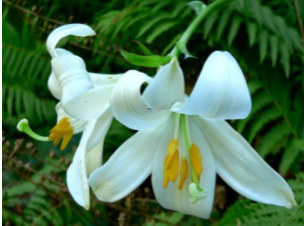
What is epiphyllous stamen?
Answer
383.7k+ views
Hint: Flower is basically a very brightly coloured modified branch, which has four main types of floral leaves, namely, sepals, petals, stamens, and carpels. Each stamen is composed of filament and anther which further contains microsporangia. There are various forms of androecium based on the different conditions of anther and filament like polyandrous, epipetalous, epiphyllous etc.
Complete answer:
When the two-accessory whorl, which are sepals and petals, are not differentiated and the leaves are alike in these or even if only one whorl is present, in this case, it is called perianth. In perianth, each floral part is called the tepals. When the stamen is attached to petals, then it is called epiphyllous. The following condition can easily be observed in Lily. In these types of flowers, each anther consists of two lobes, which is further connected with the help of connective and it is known as dithecous.
Sometimes the connective is enlarged and the lobes also tend to get separated, then this condition is described as divaricated or divergent anther lobes. Some or at times, all of the stamens in a flower might get attached to the floral axis based on the species of that particular plant. At some moment, some may be free-standing or even some may get fused. In some other types of cases, the filaments might get fused and anthers may get free, or the filaments may get fused and anthers might be free.

Note: Some forms of androecium are as follows:
(1) Polyandrous: In this form of androecium, all the stamens are free in the androecium.
(2) Epipetalous: In this form, the filament of the stamens is attached with petals.
(3) Episepalous: Here, the stamens are attached to the sepals.
(4) Synandrous: In this particular form, both the filaments and anthers are fused completely.
(5) Gynandrous: When the anthers of stamens and the stigma of carpels get united, then it is known as the Gynandrous form of androecium.
Complete answer:
When the two-accessory whorl, which are sepals and petals, are not differentiated and the leaves are alike in these or even if only one whorl is present, in this case, it is called perianth. In perianth, each floral part is called the tepals. When the stamen is attached to petals, then it is called epiphyllous. The following condition can easily be observed in Lily. In these types of flowers, each anther consists of two lobes, which is further connected with the help of connective and it is known as dithecous.
Sometimes the connective is enlarged and the lobes also tend to get separated, then this condition is described as divaricated or divergent anther lobes. Some or at times, all of the stamens in a flower might get attached to the floral axis based on the species of that particular plant. At some moment, some may be free-standing or even some may get fused. In some other types of cases, the filaments might get fused and anthers may get free, or the filaments may get fused and anthers might be free.

Note: Some forms of androecium are as follows:
(1) Polyandrous: In this form of androecium, all the stamens are free in the androecium.
(2) Epipetalous: In this form, the filament of the stamens is attached with petals.
(3) Episepalous: Here, the stamens are attached to the sepals.
(4) Synandrous: In this particular form, both the filaments and anthers are fused completely.
(5) Gynandrous: When the anthers of stamens and the stigma of carpels get united, then it is known as the Gynandrous form of androecium.
Recently Updated Pages
The correct geometry and hybridization for XeF4 are class 11 chemistry CBSE

Water softening by Clarks process uses ACalcium bicarbonate class 11 chemistry CBSE

With reference to graphite and diamond which of the class 11 chemistry CBSE

A certain household has consumed 250 units of energy class 11 physics CBSE

The lightest metal known is A beryllium B lithium C class 11 chemistry CBSE

What is the formula mass of the iodine molecule class 11 chemistry CBSE

Trending doubts
State the laws of reflection of light

One Metric ton is equal to kg A 10000 B 1000 C 100 class 11 physics CBSE

Difference Between Prokaryotic Cells and Eukaryotic Cells

How do I convert ms to kmh Give an example class 11 physics CBSE

Describe the effects of the Second World War class 11 social science CBSE

Which of the following methods is suitable for preventing class 11 chemistry CBSE




